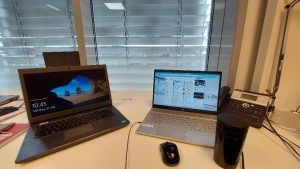Virtual event report on ‘Cellular mechanisms driven by phase separation’
Written by event reporter Ritvik Gupta
The EMBO | EMBL Symposium ‘Cellular mechanisms driven by phase separation’ occurred from 9-12 May 2022. The meeting was held on-site and virtually, with a record of over 500 attendees from all over the world. Seven lucky candidates got fellowships from the EMBO and the EMBL Advanced Training Centre Corporate Partnership Programme. These candidates travelled across the globe from India, the Czech Republic, Saudi Arabia, Poland, and Spain to attend the conference. The four-day program featured seven sessions, 50 talks, discussion panels, and countless posters showcasing the newest scientific advances in the field.
How important is phase separation for our understanding of biological processes?
Join #EESPhaseSeparation to discuss & learn from scientists from different fields about condensates in biology and disease.⏰ Submit your abstract by 14 Feb 2022
🌐 https://t.co/E72YlztBRv pic.twitter.com/SrrtfR0W5t— EMBL Events (@EMBLEvents) December 14, 2021
It was my first time attending and reporting during a virtual conference organized by EMBO & EMBL. The meeting was scheduled systematically, with links to presentations, posters, chats, and other information provided online on the login page. Moreover, the newly added discussion tab allowed the users to meet editors, talk about articles, and get advice on how to publish them. If you want to collaborate with someone or have a career-related question, this is the right place for you! You could also raise questions that come to your mind and have a fruitful discussion with other attendees.

Pre-symposium workshop
LUMICKS organized a pre-conference workshop to Unravel the Biophysical Principles Underlying Biomolecular Assemblies Using Optical Tweezers.
The revelation that various intracellular vesicles can be generated without lipid membranes has opened up new areas for research in cell biology and related domains. Transcriptional clusters, stress granules, heterochromatin domains, and DNA repair compartments are all instances of membrane-less compartments. These biomolecular assemblages enable the enrichment or exclusion of specific biomolecules, the spatial organization of nucleic acids, and the acceleration of biological events.
The panelists provided many exciting ideas from decades of expertise in their field, which is typically not readily available, particularly to early-career scientists.
Scientific sessions
The conference kicked off with opening remarks given by the scientific organizers Simon Alberti, Dorothee Dormann, Edward Lemke, and Tanja Mittag. The schedule was jam-packed with great and diverse talks covering significant aspects and hot topics in phase separation. There were seven sessions, each focussing on a different element of phase separation, thereby beautifully orchestrating a story that can helped one sequentially understand the topics and stay hooked to the presentations.
The highlights from the conference were instantly reported on Twitter using #EESPhaseSeparation. If the data presented during a talk has already been published, there is usually a link to the tweet’s associated paper(s).
What a beautiful day for a conference ☀️ We’re looking forward to welcoming you to #EESPhaseSeparation in a few hours! 🤩 pic.twitter.com/vK708jk8z6
— EMBL Events (@EMBLEvents) May 9, 2022
Talks and key-note lecture
Stephen Michnick (Université de Montréal, Canada)
Spoke about Saccharomyces cerevisiae and how, around 1 billion years ago, the genome of the budding yeast Saccharomyces cerevisiae underwent a significant decompaction due to the loss of histone H3 lysine 9 methylation. He explained how this decompaction could have caused a more remarkable ability to evolve due to processes such as highly high meiotic levels, mutation, and recombination rates. As a result of the improved evolvability, unique characteristics have made it an ideal eukaryote model and a biotechnological model.
Dr. Michnick gave instances of how variations in the mechanical characteristics of chromatin reflect locally and globally genome adaptations, indicating phase separation induced by histone post-translational modifications and resulting changes in histone exchange rates.
Rosana Collepardo Guevara (University of Cambridge, UK)
The separation of chromatin and its associated proteins in the liquid-liquid phase separation is gaining traction as a method for explaining the organization of the Eukaryotic nucleus. In this talk, Dr. Collepardo Guevara elaborated on how we can resolve individual nucleosomes within sub-Mb chromatin domains and phase-separated systems using multiscale chromatin approaches that integrate atomistic representations of DNA and proteins. The models presented by her enable us to link molecular and biophysical characteristics of individual nucleosomes to chromatin phase separation regulation. She explained how the variables that keep nucleosomes organized in a disorderly, liquid-like fashion within single chromatin arrays also favour phase separation of a solution of chromatin arrays.
Sara Cuylen-Häring (EMBL Heidelberg, Germany)
The inherently disordered protein Ki-67 covers the surface of the mitotic chromosome, the most enormous membrane-less cellular structure. Previous research has shown that Ki-67 has two functions. Ki-67 acts as a surfactant in early mitosis, preventing chromosomes from collapsing into a single chromatin mass, yet it actively promotes chromosomal clustering towards the mitotic exit. It’s still a mystery how Ki-67 flips between these two opposing activities — chromosomal dispersal and chromosome clustering.
Dr. Cuylen-Häring showed that when all chromosomes combine into a single cluster during anaphase beginning, Ki-67’s biophysical properties alter dramatically. The amphiphilic nature of Ki-67 is lost as the molecular brush structure collapses and the protein’s soluble pool condenses. Her research reveals a cell-cycle-dependent mechanism that regulates the individualization and coalescence of cells.
David Zwicker (Max Planck Institute for Dynamics and Self-Organization, Germany)
He elaborated on how biological cells are made up of thousands of different macromolecules that organize themselves into condensates and other structures. How can numerous distinct condensates reliably develop despite massive composition changes? He presented a novel numerical approach for determining coexisting phases in multicomponent systems. This method helps to maximize component interactions, similar to how evolution may have optimized biomolecule interactions. Random or contrived interactions perform worse than evolved interactions in producing a defined number of phases. The improved interactions also resist perturbations and allow for quick adaptation to new phase counts. He detailed how genetically programmed biomolecule interactions can govern the production of condensates in various ways.
Mrityunjoy Kar (MPI-Cell Biology and Genetics, Germany)
The creation and breakdown of membrane-less biomolecular condensates such as RNA-protein granules are linked to phase separation of RNA binding proteins with disordered prion-like domains and RNA binding domains. DLS, nanoparticle tracking analysis, fluorescence anisotropy, microfluidic confocal spectroscopy, and TEM investigations of cluster size distributions in sub-saturated solutions of phase-separating RNA binding proteins from the FUS-EWSR1-TAF15 (FET) family were presented by him. He elaborated how in saturated solutions, these systems exhibit heterogeneous cluster distributions. While the most prevalent species are small clusters, cluster size distributions appear to be heavily tailed. Furthermore, when bulk concentrations rise, cluster size distributions continue to trend toward bigger values. DLS tests also reveal that these clusters are reversible when diluted and concentrated, and FRET measurements show that protein molecules interchange between clusters and the bulk solution. At and beyond the saturation concentration (csat) of phase separation, these clusters coarsen and produce condensates. These observations are readily explained in terms of associative polymer theories.
Martin Wühr (Princeton University, USA)
He briefed about membrane-bound organelles like mitochondria and membrane-less biomolecular condensates (BMCs) like the nucleolus achieve compartmentalization, which is a fundamental aspect of eukaryotic life. BMCs that have been identified have liquid-like characteristics and are often viewed on a 1 µm scale. He further explained that they’ve largely been investigated using microscopy to look at certain proteins. Several dozen BMCs have been identified so far, each with a different function, such as transcription regulation, RNA management, or signaling, and their dysfunction can result in illnesses. However, it is unknown how BMCs are used in the cellular organization or at what length scale they form. At the scale of 100 nm, he showed his data that at least 18% of the proteome is structured into mesoscale BMCs. They have used differential pressure filtration, size exclusion, and dilution procedures to explore the structure of native cytoplasm on a global scale utilizing quantitative proteomics. By examining protein penetration through porous substrates with known pore diameters, they were able to confirm mesoscale sizes using imaging below the diffraction limit. The results he presented revealed that at unexpectedly short length scales, eukaryotic cytoplasm organizes itself extensively via liquid-like assemblies.
Danfeng Cai (Johns Hopkins Bloomberg School of Public Health, USA)
In 22.5 percent of papillary renal cell carcinomas (PRCCs), the Hippo pathway is dysregulated, resulting in hyperactivated YAP1/TEAD1 activity. However, it is unclear how YAP/TEAD1 contributes to PRCC development. His research group found that transcription factor TEAD1 generates liquid-like nuclear condensates inside PRCC patient-derived cell lines using super-resolution imaging and PRCC patient-derived cell lines. TEAD1 condensates appear in a variety of sizes and functions, which is intriguing.
Smaller, sub-micron-scale TEAD1 condensates facilitate active transcription, whereas larger, micron-scale TEAD1 condensates repress transcription: they lack YAP1, are devoid of active transcription markers BRD4 and H3K27Ac, and are found in different heterochromatic nucleus compartments.
Keynote lecture: A fluid paradigm for biological organization, Clifford Brangwynne (Princeton University, United States of America)
Living cells are frequently misunderstood as machines on a factory floor, operating through a clockwork-like series of interactions among their biomolecular building pieces. However, internal cell activities are far more wet and active than many textbooks would have us assume. Research integrating concepts from materials physics and cell biology has ushered in a new paradigm for understanding how this chaotic intracellular environment is brought to order through the collective condensation of disordered proteins into droplets of living information throughout the last decade. Intracellular condensates are viscoelastic states of biomolecular matter that aid dozens of intracellular processes and appear to be at the root of malignancies and neurological disorders such as Alzheimer’s and ALS.
💯 Don’t miss keynote speaker Clifford P. Brangwynne @brangwynnelab and his lecture on ‘A fluid paradigm for biological organization’ happening right now at #EESPhaseSeparation! pic.twitter.com/tHKUocOR0e
— EMBL Events (@EMBLEvents) May 11, 2022
On-site and virtual meetings
After an almost four-year-long break, the on-site event resumed at the EMBL campus in Heidelberg. People enjoyed networking and interacting with others which boosted their morale. The pandemic has taught us to come up with new approaches to our actions, and virtual meetings are one of them. Many people across the globe benefitted from the conference being set up in a hybrid format and enjoyed the amount of knowledge that this event showered upon them.

This blog post is written by Ritvik Gupta, Master’s thesis student at Didier Stainier’s Group, Max Planck Institute for Heart and Lung Research, Germany, pursuing BS-MS at IISER Mohali.
Learn more on how to become an event reporter for EMBL Events